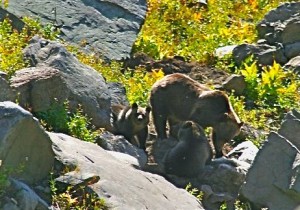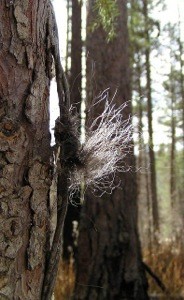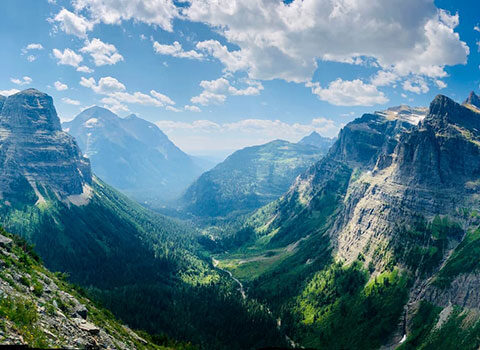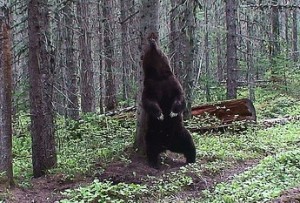
This grizzly mama found a mountain goat carcass to feast on with her cubs. Photo by Glacier Guide Sarah Metzger.
Glacier National Park has one of the most diverse eco-systems you’ll find anywhere. Our backyard national park is home to rare and spectacular creatures, including grizzly bears. Usually, the very first question our rafting, hiking, fishing, and biking guests have is directly related to:
Grizzly Bears
They want to know everything about grizzly bears. Where they sleep, what they eat (“hopefully not me, right?”), if they’re good parents, if they really go all winter without going to the bathroom … (That last one, by the way, has a super interesting answer, if you’re into nerdy science stuff like me, but more on that later.)
So, let’s talk about some myths and facts about grizzlies, as well as what to do when you find yourself in grizzly habitat.
_ What Do Grizzly Bears Eat?
Grizzlies are marvelously adaptive when it comes to filling their bellies. They are omnivores, meaning they eat food of meat and vegetable origin. Essentially, grizzly bears’ diet consists of whatever they can get their paws on, so it varies greatly based on where they live and what’s available.
The enormous grizzlies that live along the coast of BC and Alaska gorge themselves on salmon, whereas our grizzlies mostly munch on berries and other vegetation, grubs, and insects. Protein is a rare treat for Glacier’s grizzlies and they get it mostly from scavenging carcasses of ungulates, hoofed mammals like elk, deer, and mountain goats. Grizzlies also get protein from digging up small mammals like ground squirrels and pikas. Therefore, our Glacier National Park grizzly bears are much smaller than their relatives up north”: 300-700 lbs vs. 800-1,000 lbs.
_ When Do Grizzly Bears Give Birth?
Sow grizzlies (mamas are sows, males are boars) usually give birth mid-winter, in their dens. Their mating season is typically May through early July. Females will likely mate with several different males over the course of a season. After an egg is fertilized, it doesn’t implant in the female’s uterus right away, as it would in most mammals. Instead, the sow’s body waits until late October, and the fertilized egg(s) will only implant if the sow has enough body fat to support her and her offspring in the den.

Scratching their backs on trees is a favorite grizzly bear pastime. A group of scientists added wire to the bruins’ favorite rub trees in the Park and were able to collect all sorts of information about Glacier’s grizzlies from the hair they left behind. Photo by Glacier NPS.
How amazing is that?!
Grizzly Bear Cubs
Grizzly bear cubs are born helpless, hairless, and blind. They need lots of calories before it’s safe for them to leave the den to find food, so pregnancy only happens if the mama gets fat enough to support herself and her cubs through the long winter.
That’s not the only thing that makes grizzlies incredible mamas, either.
They keep cubs with them for 2-3 years, teaching them to how survive. Sows also fiercely protect cubs from anything they feel could be a threat. Male grizzlies can be aggressive towards cubs. Boars generally outweigh the sows by hundreds of pounds, but the sows will typically fight them off or die trying to keep their cubs safe.
_How Does Grizzly Bear Hibernation Work?
Contrary to popular belief, bears don’t actually hibernate. When an animal hibernates, their heart rate drops dramatically and their body temperature drops to match the temperature outside. Bears stay pretty warm during their long winter’s nap, and if you were to stick your head in a grizzly den and say hi (not a recommended winter activity), they’d be groggy, but responsive, and probably pretty annoyed.
Bears may not hibernate fully, but to conserve energy, their metabolism slows way down, and they don’t eat, drink, or go to the bathroom the entire time they are in the den. Instead, their body breaks down waste internally, then reabsorbs it and extracts additional nutrients in the process. For more great info about sleeping bears, check out this awesome post on bear metabolics by Joe Palca.
_ Am I Safe in Glacier National Park?
No, but you’re not safe in your house, on the highway, or in the grocery store either. Not really.
While there are some inherent risks that come with hiking in Grizzly habitat, your chances of injury or death are pretty slim. If you hike in Glacier, you might be lucky enough to see a grizzly, but you will most likely NOT be unlucky enough to have a negative encounter with one.
_How Do I Prevent a Negative Encounter?

Be on the lookout for big dug out areas and flipped over rocks and you’re less likely to be surprised by a grizzly.
The best way to stay safe is to avoid close encounters all together by:
Paying attention to your surroundings. Is there an abundance of berries or other enticing treats around that bears might find tasty? Are there signs of recent digging, or flipped over rocks along the trail? If you see any of those things, chances are, there is a bear nearby.
Letting the bears know where you are by making noise. Luckily, Grizzlies hear quite well and in most instances, the sound of your footfalls, the vegetation rustling as you pass, and conversations between you and your hiking buddies will create enough noise to push them away from the trail. Although, it is a good idea to make a little extra noise when visibility is poor or you are near loud, rushing water.
Pro Tip: Bear Bells do not sound like humans to grizzly bears. They sound like high-pitched, repetitive noises, AKA tasty squirrels and pikas. We do not recommend them.

This handsome griz heard us coming and took a break from foraging to pose, then high-tailed it into the brush. Photo by Karen Cameron
–Hiking in groups. There has never been a reported bear attack on a group of four or more hikers in Glacier Park. Ever. So clearly there’s something to be said for hiking in groups. Beyond bear safety, you are taking a much greater risk if you choose to spend time in the backcountry alone.
If you want more info about recreating in grizzly country, or what to do in case of an attack, the Glacier Park bear safety page is an excellent place to start! If you’re hiking in Glacier, you can stop by and grab a can of at-cost bear spray from us, too.
See you out there!
-Dre
–




